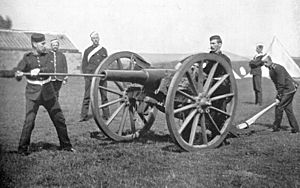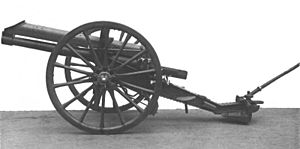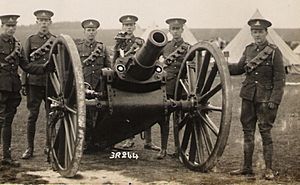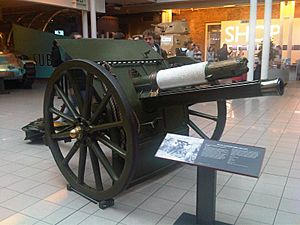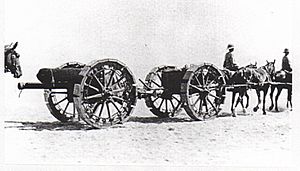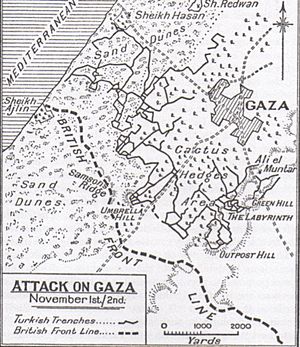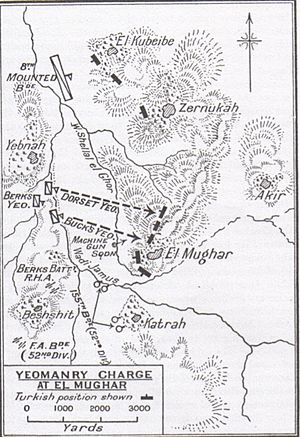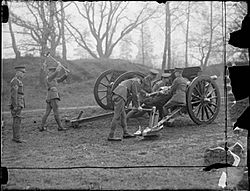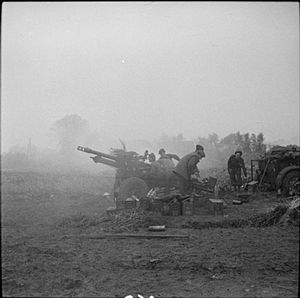1st Lanarkshire Artillery Volunteers facts for kids
Quick facts for kids 1st Lanarkshire Artillery Volunteers1st Lanarkshire RGA (V) 3rd Lowland Brigade, RFA 80th (Lowland – City of Glasgow) Field Regiment, RA 280th (City of Glasgow Artillery) Field Regiment, RA Lowland Regiment, RA |
|
|---|---|
| Active | 30 December 1859–1 April 1975 |
| Country | |
| Branch | |
| Type | Artillery |
| Role |
|
| Size | Up to 4 brigades/regiments |
| Part of | 52nd (Lowland) Division |
| Garrison/HQ | Glasgow |
| Nickname(s) | 'The Glasgow Howitzers' (IV Brigade, RFA) |
| Engagements | |
The 1st Lanarkshire Artillery Volunteers was a group of part-time soldiers. They were formed in 1859 because people worried about a possible French invasion. This unit and its later versions fought in major wars. They saw action in Gallipoli and Palestine during World War I. Later, they fought in Normandy and North West Europe in World War II. The unit continued to serve in the Territorial Army until 1961.
Contents
Artillery Volunteers: Early Years (1859-1908)
In 1859, many people wanted to help defend Britain. This led to the creation of "Volunteer Corps." These groups were made of part-time soldiers. They helped the regular British Army when needed. Several Artillery Volunteer Corps (AVCs) started in Glasgow and nearby areas.
The 1st Administrative Brigade Lanarkshire Artillery Volunteers began on March 6, 1860. It had its main office in Glasgow. This brigade included 15 different volunteer corps. Each corps had one artillery battery (a group of guns). Some of these corps were formed by skilled workers. Others were self-funded by their members.
The 1st Corps was formed after Prince Albert suggested Glasgow should have artillery. Mr. John Wilkie, a lawyer, helped set it up. It grew so fast that three batteries were formed right away. These were the 1st, 2nd, and 3rd batteries. In 1862, all 15 batteries officially became the 1st Lanarkshire Artillery Volunteers.
The 1st Lanarkshire unit used several buildings in Glasgow. These included places on St. Vincent Street and Sauchiehall Street. By the early 1900s, they had a main office and five separate drill halls. These halls stored equipment like gun-sheds. For over 30 years, they practiced shooting at Irvine.
Becoming Royal Garrison Artillery
In 1882, all volunteer artillery units joined the Royal Artillery (RA). The 1st Lanarkshire AVC became part of the Scottish Division. Later, in 1889, it moved to the Southern Division.
In 1899, the RA split into two main parts: field artillery and garrison artillery. Field artillery moves with armies on the battlefield. Garrison artillery defends fixed places like forts. All volunteer artillery units, including the 1st Lanarkshire, became part of the Royal Garrison Artillery (RGA). On January 1, 1902, the unit was renamed the 1st Lanarkshire Royal Garrison Artillery (Volunteers).
In 1900, the whole unit offered to serve in South Africa. However, artillery units were not needed there. Still, 62 members of the corps went to South Africa. They served in other roles during the war.
Using Position Artillery Guns
Volunteer artillery units were meant to defend fixed positions. But some early units used "position batteries." These were semi-mobile guns pulled by horses. Until 1865, the Lanarkshire batteries used 32-pounder smoothbore guns. Then, a new battery was formed with four 6-pounder smoothbore field-guns.
In 1888, the idea of "position artillery" came back. The 1st Lanarkshire unit was chosen to use two position batteries. Each had four 16-Pounder Rifled Muzzle Loading guns. By 1900, the unit had 20 batteries. Eight more 16-pounder guns were given to them. The unit was then reorganized into ten position batteries. They were called a "position artillery corps" in 1901. In 1902, they became "heavy artillery."
In 1905, the Army tried to change some RGA Volunteers to field artillery. The 1st Lanarkshire RGA (V) was chosen for new quick-firing guns. But this plan stopped when the government changed. Instead, a big reorganization of all army reserve forces began. By 1907-08, the 16-pounder guns were replaced. They got 15-pounder Breech Loading guns that could fire quickly. This unit was the only one in Scotland with only heavy batteries.
The Territorial Force (1908)
In 1908, the Volunteers became part of the new Territorial Force (TF). This was part of the Haldane Reforms. The soldiers from the 1st Lanarkshire RGA joined two new units. These were part of the Royal Field Artillery (RFA).
III (or 3rd) Lowland Brigade
- Main office at 8 Newton Terrace, Charing Cross, Glasgow
- 1st City of Glasgow Battery
- 2nd City of Glasgow Battery
- 3rd City of Glasgow Battery
- 3rd Lowland Ammunition Column
IV (or 4th) Lowland (Howitzer) Brigade
- Main office at 8 Newton Terrace, Charing Cross, Glasgow
- 4th City of Glasgow (Howitzer) Battery
- 5th City of Glasgow Battery
- 4th Lowland (Howitzer) Ammunition Column
These units were part of the TF's Lowland Division. The field batteries used four 15-pounder guns. The howitzer batteries used four 5-inch howitzers.
World War I (1914-1918)
Getting Ready for War
When World War I began in August 1914, the Lowland Division was at its yearly training camp. They quickly got orders to prepare for war. Soldiers started gathering at their local drill halls. They also helped with guard duties. By August 10, the division was ready.
Many TF soldiers volunteered to serve overseas. Those who only wanted to serve at home formed reserve units. Also, if a unit had enough volunteers, a "2nd Line" unit was created. These 2nd Line units had the same name but with a "2/" in front. This created duplicate units for those going overseas.
During 1914–15, the 1st Lowland Division trained for war. They also defended the Forth area in Scotland. In May 1915, it became the 52nd (Lowland) Division. This division was sent to the Dardanelles Campaign. However, it was decided that it would be too hard to use all the artillery on the Gallipoli Peninsula. So, the 1/III Lowland Brigade stayed behind to defend the Forth. The howitzers from the 1/IV Lowland Brigade went with the division to Gallipoli.
1/III Lowland Brigade in Egypt and Palestine
The 1/III Lowland Brigade finally went overseas in early 1916. They got new 18-pounder guns. They arrived in Egypt on March 10. They rejoined the 52nd (Lowland) Division. The division was defending the Suez Canal. In May 1916, the brigade was renamed CCLXI (or 261) Brigade. Its batteries became A, B, and C. The guns had special wooden blocks on their wheels called 'ped-rails'. These stopped them from sinking in the soft sand.
In September, the army in Egypt started to plan an attack into Palestine. For this, the 52nd (Lowland) Divisional Artillery was split into two groups. Each group had two 18-pounder batteries and one howitzer battery. The 52nd (Lowland) Division helped protect the railway and water pipeline being built across the Sinai Desert.
On December 25, 1916, the artillery was reorganized again. C Battery of CCLXII Brigade was split up. Its sections joined the other batteries to give them six guns each. On December 30, B/CCLXIII Battery officially joined the brigade as C (Howitzer) Battery.
Battles for Gaza
In March 1917, the army attacked Gaza. The 52nd (Lowland) Division was in reserve and its artillery did not fight in the First Battle of Gaza. This attack failed. The division then took part in the Second Battle of Gaza on April 17. CCLXII Brigade fired shells at Turkish positions. The infantry advanced, but both artillery brigades suffered casualties.
On April 18, the artillery heavily bombarded the Turkish lines. On April 19, the howitzers fired gas shells for 40 minutes. Then they fired high explosive (HE) shells. The 18-pounders joined in, creating a moving wall of explosions called a Creeping barrage. This helped the infantry attack. The 52nd (Lowland) Division attacked the important Ali Muntar position. But the gas shells had not stopped the Turkish guns. The Turkish artillery fired back heavily. The division had many casualties.
After this, there was a period of trench warfare. Both sides fired artillery at each other. The 52nd (Lowland) Divisional Artillery lost many men and guns. This was because enemy planes could easily see their positions. On July 1, 1917, C (Howitzer) Battery left. This left CCLXII Brigade with only two 18-pounder batteries.
The army got more artillery ammunition. The attack started again on November 1, 1917, with the Third Battle of Gaza. The 52nd (Lowland) Division was facing Gaza. The shelling began on October 27. This was one of the heaviest bombardments outside the Western Front. On November 1, the bombardment opened on Umbrella Hill. The infantry attacked and quickly took the hill. After more shelling, the infantry took the front line trenches. A large Turkish counter-attack was destroyed by all the artillery.
The rest of the army broke through Turkish lines further inland. By November 7, the Turks left Gaza. The 52nd (Lowland) Division chased them. The field batteries moved up the beach. They crossed a river and turned inland. They fought a strong Turkish artillery force. The Lowland infantry were pushed back four times. At one point, Turkish soldiers came very close to the artillery. But a flank attack by 6th HLI forced the Turks to retreat.
The chase continued. On November 10, 157th Brigade and B/CCLXII Battery were ordered to take Ashdod. They attacked, and B Battery quickly moved up to fire. The position was taken by midnight. The Turks still held a position at El Mughar. The army attacked it on November 13 after an hour of shelling. The important Junction Station fell the next day.
On November 19, the army moved into the Judaean Hills to close in on Jerusalem. Moving artillery on the hill roads was very hard. Heavy rain made it worse. But by using 10-horse teams, the 52nd (Lowland) Divisional Artillery got 10 guns up for an attack. This was called a "magnificent feat." Jerusalem fell without a fight on December 9.
The 52nd (Lowland) Division then moved to the coast north of Jaffa. They reached the River Auja by December 8. The Turks were in a strong position on the other side. The 52nd (Lowland) Division's infantry crossed the Auja river on the night of December 20/21. The artillery provided cover fire. Engineers built bridges, and the artillery crossed on December 22. The division quickly advanced to Arsuf.
Final Battles in Palestine
The division stayed near Arsuf until March 1918. Urgent reinforcements were needed on the Western Front in Europe. So, the 52nd (Lowland) Division was sent there. Its artillery, however, stayed in Palestine. They joined the 7th (Meerut) Division, an Indian Army formation. They served with this division until the end of the war. On April 5, CCLXII Brigade gained 438 (Howitzer) Battery with four 4.5-inch howitzers.
There was not much fighting in the coastal area during summer 1918. On May 28/29, the artillery supported an advance. On June 8, the 7th (Meerut) Division took the 'Two Sisters' hills. These hills were used by the Turks to observe. The attack started after a 15-minute bombardment.
The army was ready for its final attack in Palestine, the Battle of Megiddo on September 19. For the first attack, there was no long bombardment. When the guns fired at 4:30 AM, it was the signal for the infantry to advance. The field guns fired at enemy front lines. Then the 18-pounders created a creeping barrage. The 4.5-inch howitzers focused on important targets beyond the barrage. The barrage moved at 100 yards per minute.
The 7th (Meerut) Division pushed the Turks back. The artillery moved up. The division drove the Turks off a position by 3:00 PM. The fighting ended. The cavalry then moved past the division to continue the attack. The 7th (Meerut) Division reached Haifa on September 29. They then set off for Beirut on October 3. A group of RFA artillery went with one column. They followed engineers who widened the 'Ladder of Tyre' route for the guns. This column marched 96 miles in 8 days.
The advance continued with little Turkish resistance. The Lowland gunners reached Tripoli on October 26. They had marched 270 miles in 38 days. Fighting with Turkey ended with the Armistice of Mudros on October 30.
The Lowland Artillery stayed at Tripoli until November 22. Many soldiers died from disease there. The brigades then moved back to Egypt. They reached Cairo on December 20. In March 1919, there were civil disturbances in Egypt. The gunners formed mobile groups for patrol work. They stayed at Abbassia Barracks outside Cairo until August. Then, their demobilization (sending soldiers home) was completed. CCLXI Brigade, RFA, was then put into "suspended animation" (meaning it stopped existing for a while).
Other Lowland Brigades in WWI
- 1/IV Lowland Brigade: This unit served with the 52nd (Lowland) Division at Gallipoli. Its howitzers were the only guns from the division there. It was moved to Egypt. There, it was renamed CCLXII (or 262) (H) Brigade, RFA. It got new 4.5-inch howitzers. It fought in the Battle of Romani. It was later renamed CCLXIII (263) (H) Brigade but was broken up at the end of 1916.
Between the World Wars
When the TF was reformed in 1920, its RFA brigades had four batteries. Three had 18-pounders, and one had 4.5-inch howitzers. The five Glasgow batteries were reformed. The III Lowland Brigade now had four batteries. The 5th City of Glasgow Battery joined the I Lowland Brigade.
In 1921, the TF became the Territorial Army (TA). The III Lowland Brigade was renamed the 80th (Lowland) Brigade, RFA. It was still part of the 52nd (Lowland) Division. It had its main office at 21 Taylor Street, Townhead, Glasgow. It had four batteries:
- 317 (1st City of Glasgow) Battery
- 318 (2nd City of Glasgow) Battery
- 319 (3rd City of Glasgow) Battery
- 320 (4th City of Glasgow) (Howitzer) Battery
In peacetime, batteries only had four guns. The guns were still pulled by horses. Partial mechanization began in 1927. But the guns still had iron wheels until just before World War II. In 1924, the RFA became part of the Royal Artillery (RA). The word 'Field' was added to the names of its brigades and batteries.
In 1937, the brigade changed its name to 'Lowland – City of Glasgow'. In 1938, the RA changed its names. A "brigade" became a "regiment." This happened for TA field brigades on November 1, 1938.
World War II (1939-1945)
Getting Ready for WWII
The TA doubled in size after the Munich Crisis of 1938. Most regiments split to form duplicate units. Field artillery regiments changed from four six-gun batteries to two batteries. Each battery had three four-gun troops. For the 80th (Lowland – City of Glasgow) Field Regiment, this meant:
80th (Lowland – City of Glasgow) Field Regiment, Royal Artillery
- Regimental Headquarters (RHQ) at Glasgow
- 317 (1st City of Glasgow) Field Battery at Glasgow
- 318 (2nd City of Glasgow) Field Battery at Maryhill
131st Field Regiment, Royal Artillery
- RHQ at Glasgow
- 319 (3rd City of Glasgow) Field Battery at Glasgow
- 320 (4th City of Glasgow) Field Battery at Townhead
80th (Lowland - City of Glasgow) Field Regiment
The 80th Field Regiment joined the 52nd (Lowland) Infantry Division. They served with this division for most of the war. After the Battle of France, it was clear that two-battery regiments didn't work well. So, regiments were reorganized into three 8-gun batteries. The 80th Field Regiment formed its third battery, 458 Field Battery, by May 1941.
The 52nd (Lowland) Division stayed in Britain for most of the war. They trained for mountain warfare and air-portable operations. They finally saw action in the Battle of the Scheldt in October 1940. Then they fought in the Rhineland (Operations Blackcock and Veritable). After that, they advanced towards Bremen. The regiment was put into "suspended animation" on May 5, 1946. This happened while they were in the British Army of the Rhine (BAOR) in Germany.
131st (Lowland - City of Glasgow) Field Regiment
The 131st Field Regiment joined the 15th (Scottish) Infantry Division. They served with this division throughout the war. The regiment formed its third battery, 496, on February 27, 1941. It received its 'Lowland - City of Glasgow' subtitle in 1942.
After defending Britain, the 15th (Scottish) Division fought in Normandy. They continued fighting through North West Europe. The 131st Field Regiment did very well in action at Asten on October 28–29, 1944. It was put into "suspended animation" on January 9, 1946. It was officially disbanded when the TA was reformed in 1947.
After World War II
When the TA was reformed on January 1, 1947, the 80th (Lowland) Field Regiment was re-established. It was renamed 280th (Lowland – City of Glasgow) Medium Regiment. In 1950, it became a field regiment again. In 1955, its name changed to 'City of Glasgow Artillery'. The regiment was part of the 85 (Field) Army Group Royal Artillery. This group was renamed HQ RA 52nd (Lowland) Division in 1950. The regiment had:
- RHQ at Glasgow
- P (1st City of Glasgow) Battery
- Q (2nd City of Glasgow) Battery
- R (3rd City of Glasgow) Battery
In 1961, the TA was reduced in size. This was because National Service (mandatory military service) ended. Most of the regiment joined with the 279th (Ayrshire) Field Regiment. They formed the 279th (City of Glasgow & Ayrshire) Field Regiment:
- RHQ at Troon
- P (1st City of Glasgow) Battery
- Q (Ayrshire) Battery
- R (3rd City of Glasgow) Battery
Any extra soldiers from the 280th Field Regiment moved to the 445th (Lowland) Light Anti-Aircraft Regiment.
The Lowland Regiment, RA
In 1967, the TA was reorganized into the Territorial and Army Volunteer Reserve. The Lowland artillery regiments joined together. They formed The Lowland Regiment, RA (Territorial). This unit was for Home Defence. It had:
- RHQ at Glasgow
- HQ (City of Glasgow) Battery at Glasgow
- P (Clyde & Renfrewshire, Argyll & Sutherland Highlanders) Battery at Port Glasgow
- Q (City of Edinburgh) Battery at Edinburgh
- R (Paisley, Argyll & Sutherland Highlanders) Battery at Paisley, Renfrewshire
- S (Ayrshire) Battery at Troon
- T (Glasgow) Battery at Glasgow
In 1969, the Home Defence part of the TAVR was disbanded. The Lowland Regiment was reduced to a small group of core members. Some soldiers joined other units.
The core group of the Lowland Regiment was officially disbanded on April 1, 1975. However, in 1986, the 105 (Scottish) Air Defence Regiment was named as its successor unit.
Uniforms and Badges
The first uniform for the Lanarkshire AVCs was like the Royal Artillery's. They wore tall hats called busbies and white waist-belts. They had scarlet (bright red) cuffs and scarlet bands on their caps.
From 1908, all batteries of the 3rd and 4th Lowland Brigades wore a brass shoulder badge. It showed "T" over "RFA" over "CITY OF GLASGOW." In 1931, the unit got a special badge for the 80th Field Brigade. It showed a field gun with an oak tree above it. The tree had a robin and a bell, like on the Coat of arms of Glasgow. Above the tree was a King's crown and a scroll with the RA motto 'UBIQUE' ('Everywhere'). Below the gun was a scroll saying 'CITY OF GLASGOW ARTILLERY'. This badge was used on various items. From 1955, this design was used as a collar badge for the 280th (City of Glasgow) Field Regiment.
Commanding Officers
Here are some of the officers who led the unit:
- Lt-Col Wm. S. S. Crawford, started February 7, 1861
- Lt-Col Jas. Keid Stewart, started May 12, 1862
- Lt-Col John Kidston, started March 10, 1875
- Lt-Col Robt. J. Bennett, started September 27, 1890
- Lt-Col Alexr. B. Grant, started January 2, 1895
- Lt-Col Archibald Mclnnes Shaw, started November 16, 1907
Honorary Colonels
These people served as special Honorary Colonels for the unit:
- William S.S. Crawford (a former commanding officer), appointed January 8, 1870
- William Cavendish-Bentinck, 6th Duke of Portland, appointed March 8, 1884
- Sir Charles Cayzer, 1st Baronet, appointed March 23, 1898
- Alexander B. Grant (a former commanding officer), appointed to 4th Lowland Brigade November 23, 1912
- Sir Archibald McInnes Shaw (a former commanding officer), appointed to 80th Lowland Brigade December 21, 1921
Notable Members
Dr. George Beatson, a famous cancer specialist, joined the 1st Lanarkshire AV in 1878. He became a lieutenant in 1880 and a captain in 1885. In 1890, he left to lead the Glasgow companies of the Volunteer Medical Corps. He later became the main medical officer for the Lowland Division.


